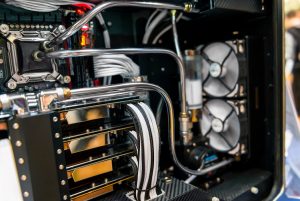 While modern heat exchangers have led the way for many different thermal management innovations, their unique air-cooling techniques haven’t been the only ones. In many high-performance, often groundbreaking applications, processes such as liquid cooling can often provide more satisfactory results. However, liquid cooling hasn’t typically been as widely available as more conventional heat exchangers. That’s largely because the process often has to be custom-designed with specialized equipment to meet each individual application’s unique needs. Today, though, heat exchangers can bring the high-capacity, consistently reliable performance of liquid cooling to increasingly more applications, thanks to their versatile nature and high customizability.
While modern heat exchangers have led the way for many different thermal management innovations, their unique air-cooling techniques haven’t been the only ones. In many high-performance, often groundbreaking applications, processes such as liquid cooling can often provide more satisfactory results. However, liquid cooling hasn’t typically been as widely available as more conventional heat exchangers. That’s largely because the process often has to be custom-designed with specialized equipment to meet each individual application’s unique needs. Today, though, heat exchangers can bring the high-capacity, consistently reliable performance of liquid cooling to increasingly more applications, thanks to their versatile nature and high customizability.
Common applications for liquid cooling
Liquid cooling is the process of transferring heat between liquids, or a liquid and another material, to facilitate rapid electrical cooling without the need for HVAC equipment. In many applications, liquid cooling is one of the most efficient ways to control electrical waste heat and, in many cases, bring temperatures inside of electrical enclosures to well below the ambient temperatures outside of them. Some of the most common applications for liquid cooling involve advanced electronics, such as large data centers, automated computer technologies, consumer products, and much more.
Combining methods in liquid cold plates
Heat exchangers have always been known for streamlining thermal management to make the process more efficient and manageable. Traditionally, they’ve been most beneficial in helping companies cut their reliance on cumbersome solutions such as air conditioners or air compression units. Heat exchangers operate on different principles of electrical cooling, relying on the efficient transfer of heat rather than the application of chilled air to prevent electrical overheating. For example, using natural/forced convection and phase-change cooling, the fluid inside of heat exchangers is able to consistently absorb, transfer, and dissipate waste heat, all without having to chill and circulate air.
The benefits of looped liquid cold plates
Liquid cold plates are just one of several different variations of modern heat exchangers. Metal plates with unique flow paths machined into them can be customized and stacked to provide optimal, cost-efficient liquid cooling for a wide variety of applications. While cold plates are often customized to meet the parameters of specific applications, advanced design analysis and manufacturing techniques allow them to be created faster and at minimal cost compared to traditional liquid cooling apparatus.
For more information about cold plate heat exchangers and looped liquid cooling, call Noren Thermal Solutions in Taylor, TX, at 866-936-6736.







